Archive for the Cultura Tibetana Category
Oferenda de Água
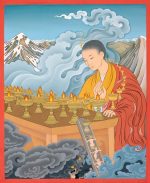 Na cultura Tibetana, o ato de dar e oferecer é venerado. Isso ajuda a reduzir nossa tendência habitual de se apegar aos bens materiais, e também acumula uma grande quantidade de mérito. Assim, oferecer água em tigelas é um método para fazer oferendas em seu altar para as Três Jóias – Buda, Dharma e Sangha.
Na cultura Tibetana, o ato de dar e oferecer é venerado. Isso ajuda a reduzir nossa tendência habitual de se apegar aos bens materiais, e também acumula uma grande quantidade de mérito. Assim, oferecer água em tigelas é um método para fazer oferendas em seu altar para as Três Jóias – Buda, Dharma e Sangha.
Na tradição budista tibetana, é usual oferecer sete tigelas de água limpa e uma lâmparina em seu altar. Estas sete tigelas representam a prática do sete ramos de prostração, oferenda, confissão, regozijo, solicitando que os Budas ensinem, pedindo aos Budas que permaneçam neste mundo e dedicação.
Na tradição de Patrul Rinpoche, às vezes é incluído um oitavo ramo de refúgio e bodhicitta. A água pura é oferecida, pois é fácil de obter e fácil de oferecer.
Referencia: https://akaracollection.com
[products_slider title=”” per_page=”12″ featured=”no” latest=”no” best_sellers=”no” on_sale=”no” orderby=”menu_order” order=”desc” layout=”default” category=”tigelas-de-oferenda, ” ]
Flecha de Longa Vida
Flecha de Longa Vida – Dadar
A flecha é a principal ferramenta para magnetizar realizações em práticas de longa vida e riqueza. Como tal, ter uma boa qualidade de seta feita de acordo com as instruções antigas é muito importante.
A própria flecha representa meios habilidosos e a pena em um dos extremos simboliza a sabedoria. As fitas de pano de cinco cores, ficam em última análise para as cinco sabedoria, mas também podem ser vistas como as cinco famílias de Buda e os cinco elementos.
A seta é fabricada com eixo de bambu cultivado em lugares sagrados e também possui os cinco metais – ferro para a base da ponta da seta, metal branco para a ponta da ponta da flecha, cobre para o nock, e algumas peças são douradas ou banhadas a prata. A flecha também é lindamente adornada com um espelho prateado, turquesa tibetana e outras pérolas preciosas, conforme recomendado nos textos tradicionais.
Referencia: https://akaracollection.com
[products_slider title=”” per_page=”12″ featured=”no” latest=”no” best_sellers=”no” on_sale=”no” orderby=”menu_order” order=”desc” layout=”default” category=”ritual, ” ]
Dadar
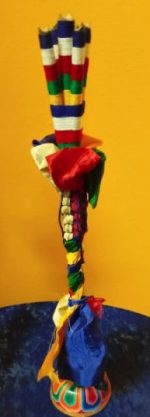 Dadar (མདའ་དར), ou dathar: é uma vareta de madeira ou bamboo onde são amarrados tecidos e fios nas cinco cores – branco, azul, amarela, verde e vermela – representando as Cinco Famílias Búdicas. Este instrumento é usado na cultura tibetana nas cerimônias de iniciação, longevidade e casamentos, também é utilizada para banir negatividades e proteger a boa sorte.
Dadar (མདའ་དར), ou dathar: é uma vareta de madeira ou bamboo onde são amarrados tecidos e fios nas cinco cores – branco, azul, amarela, verde e vermela – representando as Cinco Famílias Búdicas. Este instrumento é usado na cultura tibetana nas cerimônias de iniciação, longevidade e casamentos, também é utilizada para banir negatividades e proteger a boa sorte.
É um dos implementos de Mandarava e Sahara.
[products_slider title=”” per_page=”12″ featured=”no” latest=”no” best_sellers=”no” on_sale=”no” orderby=”menu_order” order=”desc” layout=”default” category=”altar, ” ]
Sílaba Khang
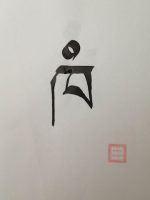 Sílaba Khang – Earth: [ས]
Sílaba Khang – Earth: [ས]
A sílaba semente para o elemento terra é “KHAM”. Meditar nessa sílaba transforma a ignorância na sabedoria e traz apoio para as transformações. Quando esta sílaba de sementes é entoada, ela é pronunciada, “KHANG”.
Fonte: http://gyalshenstore.com/
[products_slider title=”” per_page=”12″ featured=”no” latest=”no” best_sellers=”no” on_sale=”no” orderby=”menu_order” order=”desc” layout=”default” category=”livros, ” ]Sílaba Ran
A sílaba semente para fogo é “RAM”. Meditar nesta sílaba transforma a ganância e o desejo de generosidade e apóia uma presença criativa e energética.
Fonte: http://gyalshenstore.com/
[products_slider title=”” per_page=”12″ featured=”no” latest=”no” best_sellers=”no” on_sale=”no” orderby=”menu_order” order=”desc” layout=”default” category=”ritual, ” ]Sílaba Mang
Mam – Água [ཆུ]
A sílaba de semente para água é “MAM”. Meditar nesta silába transforma e pacífica a inveja e aumenta a gentilesa. Quando esta sílaba de sementes é entoada, ela é pronunciada, “MANG”.
Fonte: http://gyalshenstore.com/
[products_slider title=”” per_page=”12″ featured=”no” latest=”no” best_sellers=”no” on_sale=”no” orderby=”menu_order” order=”desc” layout=”default” category=”livros, ” ]
Sílaba Yang
A sílaba semente para o elemento ar é “YAM”. Meditar nessa sílaba transforma orgulho em paz, apoia a flexibilidade e a comunicação. Quando esta sílaba semente é entoada, é pronunciada, “YANG”.
Fonte: http://gyalshenstore.com/
[products_slider title=”” per_page=”12″ featured=”no” latest=”no” best_sellers=”no” on_sale=”no” orderby=”menu_order” order=”desc” layout=”default” category=”livros, ” ]
Amrita
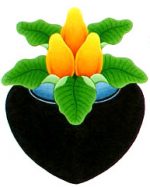 Amrita (Skt. Amrita ; Tib. བདུད་ རྩི་ , dutsi , Wyl. Bdud rtsi ) – a palavra sânscrita amrita significa “imortal”; no tibetano é བདུད་ རྩི་, dütsi , porque, diz-se, “é o remédio que supera o temível estado de morte”.
Amrita (Skt. Amrita ; Tib. བདུད་ རྩི་ , dutsi , Wyl. Bdud rtsi ) – a palavra sânscrita amrita significa “imortal”; no tibetano é བདུད་ རྩི་, dütsi , porque, diz-se, “é o remédio que supera o temível estado de morte”.
O Tantra do Ciclo Secreto diz:
-
-
Para samsara que é como mara (བདུད་, dü)
Quando o elixir (རྩི་, ts ) da verdade do Dharma é aplicado,
É chamado néctar ( བདུད་ རྩི་ , dütsi).
O néctar medicinal da amrita cura e repara os siddhis, ou realizações, em todas as dimensões.
O décimo terceiro dalai-lama escreveu: “Todos os siddhis, diz-se, incluindo a realização do corpo vajra da imortalidade, vêm como resultado das qualidades da amrita”. Os Oito Volumes no Néctar explicam:
-
Curando as quatrocentas e vinte e quatro doenças
E destruindo as quatro maras,
É a essência suprema, o rei dos remédios.
- Fonte: http://www.rigpawiki.org/index.php?title=Amrita
-
6 Paramitas
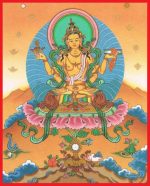 Paramita (em sânscrito) ou Parami (em pali): “Perfeição” ou “Transcendente” (lit. “Que alcançou a outra margem”). No budismo, chama-se de paramitas as perfeições ou culminações de certas práticas. Tais práticas são cultivadas por bodhisattvas para percorrer o caminho à iluminação.
Paramita (em sânscrito) ou Parami (em pali): “Perfeição” ou “Transcendente” (lit. “Que alcançou a outra margem”). No budismo, chama-se de paramitas as perfeições ou culminações de certas práticas. Tais práticas são cultivadas por bodhisattvas para percorrer o caminho à iluminação.
As Seis Paramitas, ou Seis Perfeições transcendentes(Skt. ṣaṭpāramitā; Tib. ཕ་རོལ་ཏུ་ཕྱིན་པ་དྲུག་, parol tu chinpa druk; Wyl. pha rol tu phyin pa drug), compreendem o treinamento do bodhisattva, que é a bodhichita em ação.
- Generosidade (Skt. dāna; Tib. སྦྱིན་པ་, jinpa): cultivar a atitude de generozidade.
- Disciplina (Skt. śīla; Tib. ཚུལ་ཁྲིམས་, tsultrim): abstenção de danos.
- Paciência (Skt. kṣānti; Tib. བཟོད་པ་, zöpa): capacidade de não ser perturbado por nada.
- Diligência (Skt. vīrya; Tib. བརྩོན་འགྲུས་, tsöndrü): encontrar alegria no que é virtuoso, positivo ou saudável.
- Concentração Meditativa (Skt. dhyāna; Tib. བསམ་གཏན་, samten): não se distrair.
- Sabedoria (Skt. prajñā; Tib. ཤེས་རབ་, sherab): a perfeita discriminação dos fenômenos, todas as coisas conhecíveis.
As primeiras 5 paramitas correspondem à acumulação de mérito, e a sexta paramita à acumulação de sabedoria. A sexta paramita pode ser dividida em mais 4 paramitas, resultando em Dez Paramitas.
7. Meios Hábeis (Skt. upāyakauśalapāramitā; Tib. ཐབས་ལ་མཁས་པ་, tap la khepa; Wyl. thabs la mkhas pa),
8. Força (Skt. balapāramitā; Tib. སྟོབས་, top; Wyl. stobs),
9. Aspiração (Skt. praṇidhānapāramitā; Tib. སྨོན་ལམ་, mönlam; Wyl. smon lam) and
10. Sabedoria Primordial (Skt. jñānapāramitā; Tib. ཡེ་ཤེས་, yeshe; Wyl. ye shes).
A maneira de dividir as paramitas em dez é particularmente relacionada aos ensinamentos sobre os bhumis que descrevem a progressão de um bodhisattva, em que cada uma das paramitas é sucessivamente aperfeiçoada em cada um dos dez bhumis .
Referencia https://pt.wikipedia.org/wiki/Paramitas
Oito Stupas
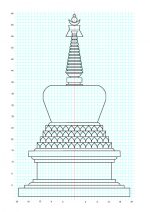 (1) Stupa of Heaped Lotuses
(1) Stupa of Heaped Lotuses
Commemorates the Buddha’s birth at Lumbini, where he took seven steps in each of the four directions, from which lotuses sprang.
The Lotus Blossom Chorten
The Chorten is also known as the Chorten of heaped Lotuses. It refers to the birth of the Buddha. At birth Buddha took seven steps in each of the four directions- East, South, West and North. In each direction lotuses sprang, symbolising the four immeasurable of love, compassion, joy and equanimity.
The four steps of the basis of the Chorten are circular, and decorated with lotus-petal designs. Seven heaped lotus steps are constructed occasionally. This refers to the seven first steps of the Buddha.
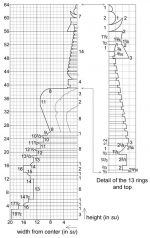 (2) Stupa of Awakening (Enlightenment) or the Conquest of Mara
(2) Stupa of Awakening (Enlightenment) or the Conquest of Mara
Commemorates the Buddha’s defeat of Mara, and his awakeningt under the bodhi tree at Bodhgaya.
This enlightenment Chorten is also known as the Chorten of the conquest of Mara. It symbolises the 35 year old Buddha’s attainment of enlightenment in the village of Magadha in Bodhgaya under the Bodhi tree on the 15th day of the 4thmonth in the Bhutanese calendar.
It is here that the Buddha subdued all the evils and conquest worldly temptations and attacks manifesting in the form of Mara.
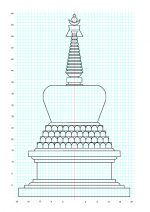
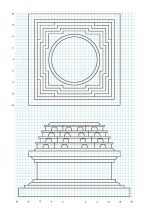 (3) Stupa of Many Doors or Gates
(3) Stupa of Many Doors or Gates
Commemorates the Buddha’s first turning of the Wheel of Dharma in the Deer Park at Sarnath near Varanasi.
The Chorten of many Doors
The Chorten of many Doors is also known as the Chorten of many gates. After attaining enlightenment, the Buddha taught his first students in a deer park near Sarnath in Varanasi on the 4th day of the Sixth Bhutanese month.
The series of doors on each side of the steps represent the first teachings of the Buddha- the four noble truths, the six perfections and the noble eightfold path.
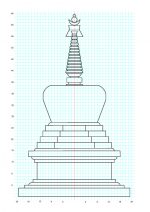
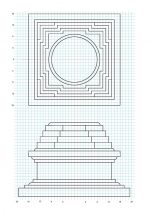 (4) Stupa of Miracles
(4) Stupa of Miracles
Commemorates the Buddha’s miraculous defeat of the non-Buddhists (tirthika) in the Jetvana Grove at Shravasti.
The Chorten of descent from the God Realm
At the age of 42, Buddha spent a summer retreat in Tushita Heaven, where his mother had taken rebirth. In order to repay her kindness he taught the dharma to his mother reincarnate. So in order to commemorate this event the local inhabitants built a Chorten on the 22nd day of the 9th Bhutanese month.
This stupa is characterised with a central projection at each side containing a triple ladder or steps.
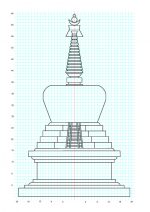
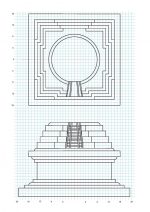 (5) Stupa of Descent from the God Realm
(5) Stupa of Descent from the God Realm
Commemorates the summer retreat that the Buddha spent teaching the reincarnation of his mother in the heavenly realm of Tushita, and his descent from this realm at the city of Sankasya.
The Chorten of great miracles
This Chorten refers to various miracles performed by the Buddha when he was 50 years old. Legend claims that he overpowered Maras and heretics by engaging them in intellectual arguments and also by performing miracles.
This Chorten was raised by the Lichavi Kingdom to commemorate the event.
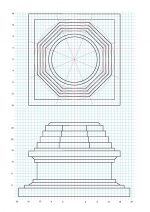
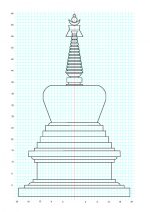 (6) Stupa of Reconciliation
(6) Stupa of Reconciliation
Commemorates the Buddha’s reconciliation of the disputing factions within the Sangha at Veluvana bamboo grove at Rajagriha.
The Chorten of reconciliation
According to Lam Neten of Wangduephodrang this Chorten commemorated the Buddha’s resolution of a dispute among the Sanga or among the Buddhist community.
“A Chorten in this design was built in the kingdom of Magadha, where the reconciliation occurred.
It has four octagonal steps with equal sides.”
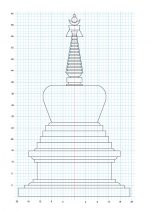
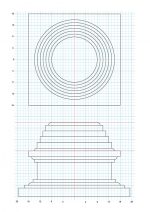 (7) Stupa of Complete Victory
(7) Stupa of Complete Victory
Commemorates the Buddha’s prolonging of his life by three months at the city of Vaisali, when he was 80 years of age.
The Chorten of complete victory
When the Buddha was 80 years old, on the request of the king of the evils Buddha decided to attain the state of Parinirvana. But the devotees again requested the Buddha to still stay alive.
So, the Buddha then prolonged his life by three months.
In order to commemorate the prolonged life of Buddha this Chorten of complete victory was built.
It has only three steps, which are circular and unadorned.
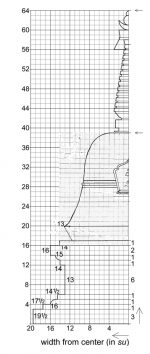 (8) Stupa of Parinirvana
(8) Stupa of Parinirvana
Commemorates the Buddha’s passing away beyond sorrow between two sal trees at the city of Kushinigara.
The common elements of these eight types of stupas are the foundation up to the lion throne, and the upper part from the rings upward. The middle section is where the different forms are realized.
This Chorten refers to the death of the Buddha, when he was 80 years old. It symbolises the Buddha’s complete absorption in to the highest state of mind.
It is bell shaped and usually not ornamented.
The Lam Neten of Wangduephodrang said that building a Chorten is considered extremely beneficial leaving very positive and accumulating merits in one’s life. “At times we should circumambulate the stupa with the inner thought of the teachings of the great masters,” he said.
Buddhists believe destroying or vandalising a stupa on the other hand is considered an extremely negative deed. According to the Lam Neten, such an action is believed to create massive negative karmic imprints leading to the massive future problems during the present stay and even after death.
There are five mantras that Lama Zopa Rinpoche says should go in all statues and stupas. Mantras should always be rolled starting from the beginning of the mantra with the words rolled inside. Once rolled, one should draw an arrow on the outside of the roll indicating which side is up. Always place the mantras right side up inside the stupa or statue. If the statue or stupa is very small, then you can roll all five mantras together so they will all fitinside. Alternatively, you can make rolls of each of the five individually and put them inside in any order. If one has also the set of mantras called de.nga, the five powerful mantras, one can also put some of these inside, though the main portion of mantras placed inside should consist of the five mantras below.
The five mantras are:
(1) Stainless Beam root mantra, (2) Stainless Beam mantra, (3) the Most Precious Mantra Ornament of Enlightenment, (4) the Most Precious Mantra of the Secret Relic, and (5) Stainless Pinnacle mantra.
Regarding the tsog.shing mantra at the bottom of this page, this is to be written in gold in the four directions on the central pole (life tree) of large statues and stupas.
Regarding the Stainless Beam mantra, Lama Zopa Rinpoche says that if you offer a bell to a stupa that contains this mantra, the sound of the bell will purify the ten non-virtues and the five uninterrupted negative karmas of all who hear it. Also, if one circumambulates a stupa or statue that contains this mantra, it will also purify the ten non-virtues and the five uninterrupted negative karmas.
Regarding the Most Precious Mantra Ornament of Enlightenment, by putting this inside one receives the benefit of building 100,000 stupas.
Regarding the Most Precious Mantra of the Secret Relic, if one circumambulates a stupa that contains even one of these mantras, it will purify the causes ofthe eight hot hells.
THE TWENTY-FOUR ELEMENTS OF A STUPA
 |
For our purposes let’s label 4 sections:
|
FILLING A STUPA
1. The throne:
should be filled with the “wordly” substances and ojects, not mantras or statues or texts etc. You can place 4 vases in the throne –
i) treasure vase containing gold, silver, pearls, turquoise, conch shells and other jewels and semi-precious stones etc.
ii) grains vase containing wheat, barley, rice, yellow peas and unhusked rice
iii) medicinal vase containing (Tib.) le tre, gyatso luwa, kanda kari (half caterpillar, half fungus), lagpa wangpo and shudag karpo
iv) aromatics vase containing red and white sandalwoods, camphor saffron, nutmeg
Other items are new clothing, weapons, knives, cars, globe of the world, honey, butter, sugar, tea, meat, five coloured cloths (signifying the five wisdoms), magazines, pictures of masses of people, pictures of famous, influential people, pictures of rich people, soil etc. from holy places. If there is much space then it can be filled with more grains and other foodstuffs (sealed off from insects), and incense and aromatic wood etc. The Dzambala mandala should go in the throne under the sog.shing.
2. The sog.shing (life-tree or life-wood) goes through the centre of the stupa from the base of the steps (bang rim) up to the top of the 13 rings.
3. The 4 steps and vase:
filled with Dharma objects such as tsatsas and statues, mantras, texts, relics. Imagining that a buddha is sitting inside the stupa with the head touching the top of the vase and the legs crossed at the base of the 4 steps, the various statues, mantra rolls texts and relics should be placed at the appropriate level. The largest number of mantras should be the 4 Dharmakaya Relic mantras which can be placed anywhere.
This is advice given directly by Lama Zopa Rinpoche regarding stupas –
The two garlands on either side of the 13 rings should not be regarded as optional, as decorations. They have significance as they symbolize the 2 truths.
Dec 26, 2011 Once a stupa has been consecrated there should not be any structural work done on the body of the stupa, such as drilling, chipping or modifying. Adding things, like paint, decorations, is OK. If renovation work has to be done there is a special process for temorarily “storing” the transcendental wisdom invoked during the consecration.
Jan 7, 2011 “All stupas have 4 levels, it signifies the 4 mindfulness’s of the 37 wings to Enlightenment. Rinpoche said he has seen stupas with 3 levels but better to keep to 4 as it has significance.”
Contents of Stupa
This Stupa of great liberation through eye sight will contain the following texts and statues:

Le mandala “eu sel drimé ki”
The mandala “eu sel drimé ki” comprises:

All statues will be bought in Nepal, all texts will come from the Tibetan printers of Delhi.
Seat of the mind touk ten
Kadampas stupas, and the eight noble stupas, two-feet tall.
In total, 108 stupas will come from Nepal. The global budget for the seats of body, speech and mind has been included in the estimate provided by the architect.
1. The reason why there is a Tree of Life inside stupas and statues, is because it represents our central channel or nadi, as explained by Dordrak rigdzin chenpo Péma Trinlé in the text “Mirror of Sapphire”.

2. In front of the Tree of Life stands the wheel “tsok dak langpo”, as illustrated below. It is an emanation of the great being of compassion Avalokiteshvra and the source of all wealth. This wheel will be made of red copper and will be 2.5 feet wide.

3. Around each mandala, 7 traditional silver offering bowls, a silver vase, a silver offering mandala, a silver butter lamp, a vajra, a bell, a damaru, a silver serkyem for offerings to Mahakala, and a kapala. In all four directions, all these offerings will be present.
4. Around the vase of the stupa, the following offerings will be made in the four directions: the 8 auspicious signs, the 8 auspicious substances, the 7 possessions of the universal monarch, the 5 objects of pleasure, the 7 types of jewels. All these offerings will be made in copper.
5. Sound offerings: various cymbals, drums, gyaling, large horns, conchs, and small cymbals, all in the four directions.
6. In the center of the vase, the mandala “tsouk tor drimé ki” will stand, as illustrated below:

7. The base of the vase will comprise the following wheels neu djin po khor mo khor. The reason is that, through blessings of the Seats of Body and Mind, the suffering in all countries due to poverty, hunger and thirst will be dispelled. Thus, all beings will experience joy, happiness, and prosperity. These two-feet-wide wheels will be in copper.

The total amount for the seats of body and mind has been included in the architect’s estimate.

1. First of all, above the vase, thirteen levels and the summit will be in copper covered by gold, to 11.26 meters height.

Vajrakila
2. In the cavity of the vase, a 3-meter-high Vajrakila statue will be placed as below, made from clay, mendroup and precious medicinal substances.
3. In this stupa of great liberation through eye sight, there will be 3 temples. The temples (A,B,C) shall comprise the following statues:

A
A. In the first temple, a 2-meters-high statue of thousand-arms Avalokiteshvara will be placed, surrounded by the 8 noble Boddhisttvas, 1.5-meter, all made from clay, men droup and precious medicinal substances.
 B
B
B. In the second temple, a Sakyamuni Buddha statue, 3.5-meter-high, surrounded by 1.5-meter Shariputra and Mauglayana on the the right, 2-meters Longchenpa and Pema Lingpa on the left, all made from clay, men droup and precious medicinal substances.

C
C. In the third temple, a 2.5 meter Gourou nang sid sil neu surrounded by 1.5-meter Yeshe Tsogyal and Mandarava on the right, 2-meter Guru drakpo and Dorjé Drolo on the left, all made from clay, mendroup and precious medicinal substances.
The total amount for the 13 levels of the summit, all statues, substances contents and paintings of frescoes, has been included in the architect’s estimate. .
In all 8 stupas, the following texts and statues will be placed:
Seat of the Mind touk ten
In each stupa, there will be a kadampa stupa, 3000 tsa-tsa, mandalas, a Tree of Life, offerings, a wheel tsok dak langpo, a wheel neu djin po khor mo khor and offerings as in the large stupa.
The total amount for the seats of body, speech and mind has been included in the architect’s estimate.


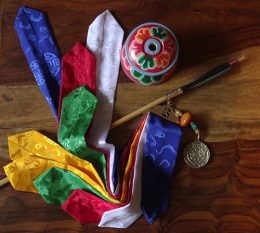
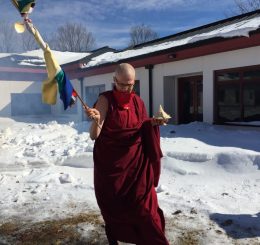
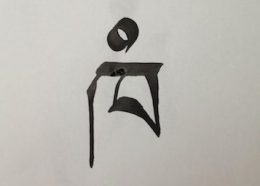
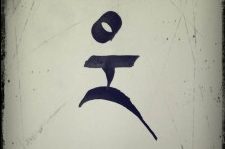
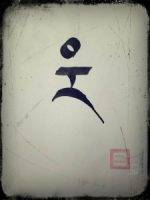
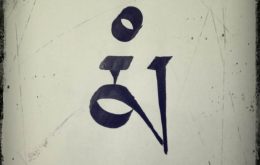
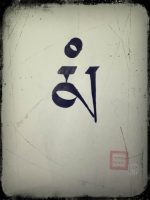
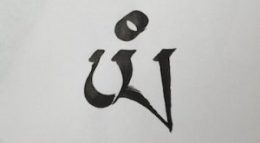
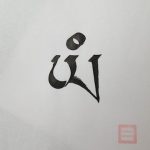
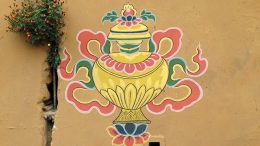
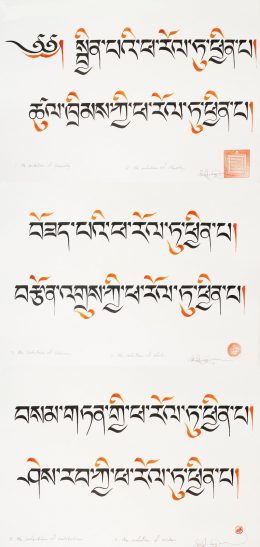
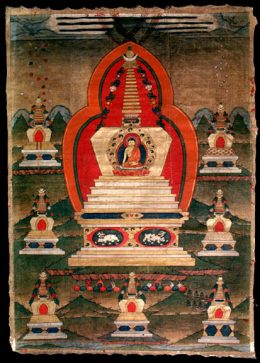




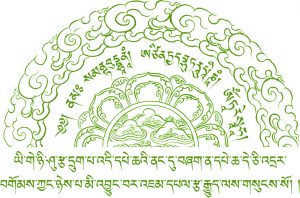
 Cintamani - Meditação e Arte - Copyright 2020 - Todos os direitos reservados.
Cintamani - Meditação e Arte - Copyright 2020 - Todos os direitos reservados.